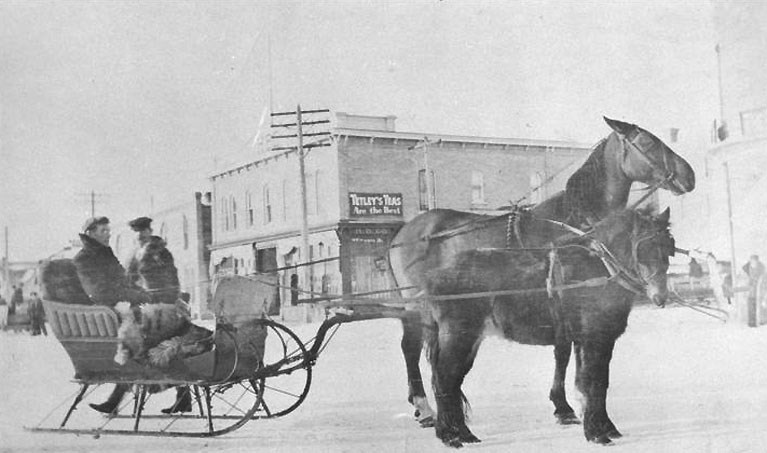Fred O. Langstaff, freighter is shown here on Broadway Street in his cutter hitched to a poorly matched team, Dick the horse, and Jumbo, the Shetland pony. The building in the background on the corner of Second Avenue North is the first Hudson’s Bay Company store. In the 1890s, a Mr. Fischer established 4 trading posts between Fort Qu’Appelle and Fort Pelly, and one at Nut Lake about six miles from where the town of Rose Valley now stands. For a few years, Langstaff was hired by a Winnipeg fur supply company to oversee the trade at the Nut Lake post. He travelled to this post, a distance of 130 miles every fortnight on the old Carleton Trail by way of present day towns of Springside, Theodore, Foam Lake, and Fishing Lake. He was accompanied by an interpreter, Johnny Brass because a lot of the trading business was with Aboriginal trappers of the area. In a 1965 interview he explained, “Brass was well acquainted with the territory and the people, having been a former mail-packet carrier in the Territories.” They also picked up supplies for the post at the Great West Trading Company in Yorkton, these being dress goods, fabrics, flour, sugar, tea, butter, dried fruits, molasses, etc. The Aboriginals traded furs — mostly muskrat, and some mink for goods. On each trip, Langstaff also brought along cats for sale. Fischer’s post readily bought the cats, as they were badly needed to control the mice. For the journey, the freighters wore mackinaws, or buffalo coats, fur hats, moose hide moccasins and 2 or 3 pairs of woolen socks, and covered themselves with a buffalo robe. Along the way, they made camp, heated up beans and meat, with buttered bread and tea.
This edition of History Corner originally ran in the Jan. 20, 2010 edition of Yorkton This Week.
Terri Lefebvre-Prince



